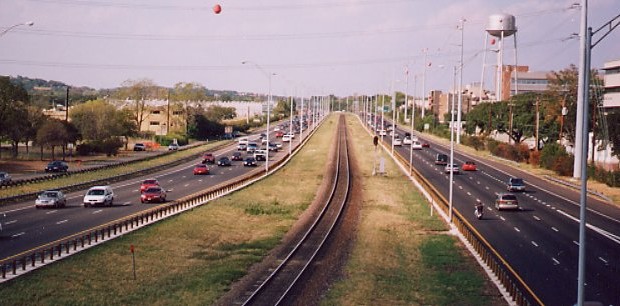Council formally weighs in on MoPac South plan
Friday, May 8, 2015 by
Tyler Whitson After weeks of mounting tension over what many call a “double-decking” of MoPac Expressway over Lady Bird Lake, City Council has formally asked the regional transportation planning body to modify a proposal to add four express lanes to a section of the highway in its upcoming plan.
Council passed a resolution Thursday requesting that the Capital Area Metropolitan Planning Organization Transportation Policy Board define the MoPac South expansion project in its 2040 Regional Transportation Plan as consisting of a “reconfiguration of South MoPac, with an unspecified or a variable number of lanes, not to exceed two managed lanes in each direction.”
The resolution also requests that the CAMPO board “approve the optimum configuration after completion of the study and analysis now underway” and “after completing and basing the decision on a thorough environmental, traffic and funding study and analysis.”
As currently written, the plan lists the project as consisting of two express lanes in each direction. Council did not request any changes to the project’s boundaries, which are Cesar Chavez Street and Slaughter Lane.
The board will consider adopting the 2040 plan at its regular meeting Monday.
The discussion leading up to adoption centered around concerns that Austin and Travis County residents and elected officials have expressed about a design proposal put forward by the project’s sponsor, the Central Texas Regional Mobility Authority.
That design includes two elevated lanes on MoPac over Lady Bird Lake with a flyover connecting to Cesar Chavez adjacent to Austin High School.
Though CTRMA did not present conceptual renderings of that specific design to the public until late February, the organization’s executive director Mike Heiligenstein said it presented the four-lane alternative as an option to the public in late 2013.
In a public hearing before the vote, citizens argued against the project, saying it would damage the environment, mar the beauty of the riverfront and increase congestion on Cesar Chavez. Others said it would present a safety hazard to Austin High School students, have a minimal impact on mobility and serve those who can afford to pay for variable tolls that may spike during peak hours.
Citizens in support of the project said it is a desperately needed mobility improvement and would encourage transit use and reduce emissions associated with congestion.
Mayor Pro Tem Kathie Tovo, who sponsored the original resolution, said she wanted to make sure the double-deck design is not a “foregone conclusion” and that the CAMPO board would have an opportunity to confirm or deny that design after it adopts the 2040 plan.
Mayor Steve Adler, who proposed the substitute resolution that Council ultimately adopted, said he wanted to ensure that those involved in the project are considering every available option, along with the concerns of Austin residents.
Both Tovo and Adler said they want Transportation Department staff to have an opportunity to propose alternative design and have the CTRMA and CAMPO boards seriously consider those proposals. That request is also included in the adopted resolution, with a requirement that staff present the alternative to the Council Mobility Committee by the end of June.
Heiligenstein told the Austin Monitor that CTRMA has expanded the available options and is planning an open house for public input late this summer.
“We’ve got four or five different concepts that we’re going to include in our studies from this point forward,” Heiligenstein said. Among those, he continued, would be the current proposal, along with “two lanes in each direction with no downtown connection,” “one lane with no connection” and “one lane with a connection.”
The options without downtown connections, Heiligenstein said, would not include the elevated lanes and flyover connection with Cesar Chavez. He added that the “no-build” option CTRMA once had available is “off the table.”
CAMPO Executive Director Ashby Johnson told the Monitor that the safeguards written into the resolution are “already federal law.” He said the CAMPO board would have two additional opportunities to confirm the project, which is currently in its environmental study phase.
The first additional opportunity, Johnson said, will come when CTRMA presents its “locally preferred alternative” to the CAMPO board, which will have a chance to review all options and vote to concur with or deny the recommendation.
After that step is complete, and once CTRMA secures funding for the project, either CTRMA or the Texas Department of Transportation would have to come back to the CAMPO board and ask to incorporate the plan into the Transportation Improvement Program, which consists of the first five years, or, as Johnson described it, “the action part of the plan.”
The resolution directs staff to work with the mobility authority, Travis County and the City of Rollingwood, which abuts MoPac, to study the transportation and environmental impacts on Cesar Chavez, West Fifth Street, Austin High School, Zilker Park, Lady Bird Lake and adjacent neighborhoods.
You're a community leader
And we’re honored you look to us for serious, in-depth news. You know a strong community needs local and dedicated watchdog reporting. We’re here for you and that won’t change. Now will you take the powerful next step and support our nonprofit news organization?











